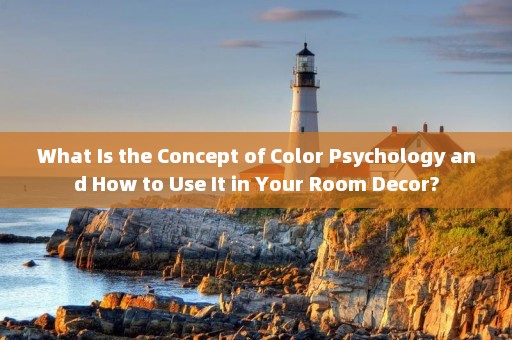As a provider of interior design services, I've seen firsthand how colors can dramatically transform the atmosphere of a room. Over the years, I've witnessed clients' faces light up as their living spaces were revitalized with a fresh coat of paint in just the right hue. This led me to delve deeper into the fascinating field of color psychology and how it can be harnessed to create rooms that not only look good but also make us feel good. In this blog post, I'll share my insights and practical instructions on how to use color psychology to enhance your room decor.

Understanding Color Psychology
Color psychology is the study of how colors influence human behavior, emotions, and perceptions. Different colors evoke different responses in people, making them an essential element in creating a desired atmosphere in your home. Let's explore some key colors and their psychological effects:
Red
Red is often associated with passion, energy, and stimulation. It has been found to increase heart rate and respiratory rate. However, it's important to use red judiciously, as excessive exposure can be overwhelming. A red accent wall or decorative objects can infuse a room with vitality without being too dominant.
Blue
Blue is known for its calming and relaxing properties. It has been shown to lower blood pressure and reduce stress. Incorporating blue into your room decor, such as through wall paint or furniture, can create a serene environment. Lighter shades of blue promote a sense of tranquility, while darker blues add depth and sophistication.
Green
Green is associated with nature, balance, and growth. It has a soothing effect on the eyes and mind, making it ideal for areas where relaxation is paramount, such as bedrooms or reading nooks. Green also symbolizes freshness and renewal, so consider using it in spaces where you seek inspiration or want to feel revitalized.
Yellow
Yellow is a joyful, uplifting color that stimulates the brain and enhances concentration. It is often used in kitchens and dining areas to create a warm and inviting atmosphere. However, be cautious with yellow, as it can become overpowering in large doses. Opt for softer shades or use it as an accent color to brighten up a room.
Using Color Psychology in Your Room Decor
Now that you understand the basics of color psychology, let's explore how to apply this knowledge to your room decor:
Identify Your Goals
Before choosing colors, determine the purpose of each room and how you want to feel when you're in it. Do you seek relaxation in your bedroom, creativity in your home office, or energy in your living room? This will guide your color choices and help create a harmonious atmosphere.
Choose a Color Scheme
Once you've identified your goals, select a color scheme that aligns with those feelings. Consider using a dominant color for the walls and complementary colors for accents. Incorporating neutral tones like white, gray, or beige can balance the overall look and prevent the space from becoming too overwhelming.
Consider Lighting
Lighting plays a crucial role in how colors appear in a room. Natural light can change the perception of colors throughout the day, while artificial light can alter their intensity. Be sure to test paint samples under different lighting conditions to ensure the colors you choose will create the desired atmosphere.
Implement Textures and Patterns
Textures and patterns can add depth and visual interest to your room decor. They can also influence the psychological impact of colors. For example, a plush rug in a warm color can make a room feel cozy and inviting, while a sleek, polished surface in a cool color can convey a sense of elegance and sophistication.
Balance and Proportion
When using color in your decor, balance and proportion are key. Avoid using too many bold colors or patterns, as they can create visual clutter and make a room feel overwhelming. Instead, focus on creating a harmonious blend of colors and textures that complement each other.
Precautions to Consider
While color psychology can be a powerful tool in room decor, it's important to take certain precautions to ensure a successful outcome:
- Avoid making decisions based solely on trends. Choose colors that resonate with you and align with your personal preferences.
- Be mindful of the size of the room. Darker colors can make a small space feel even smaller, while lighter colors can help it appear larger.
- Consider the emotional impact of colors on different individuals. What may be calming for one person could be depressing for another.
- Remember that color preferences can change over time. Choose a color scheme that is versatile and can be easily updated or altered.
Conclusion
Color psychology is a fascinating field that can greatly enhance your room decor. By understanding the emotional and psychological effects of different colors, you can create spaces that not only look beautiful but also make you feel happier, calmer, or more inspired. Remember to identify your goals, choose a color scheme, consider lighting and textures, and take necessary precautions to achieve a balanced and harmonious atmosphere in your home.
As a provider, I'm here to assist you in navigating the world of color psychology and creating a room decor that truly reflects your personality and desired ambiance. So, let's unleash your creativity and design spaces that bring joy, comfort, and inspiration into your daily life.
Post a comment

Comment List